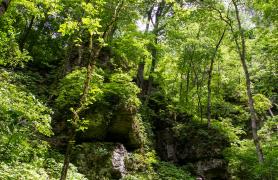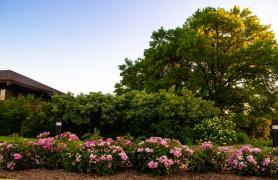Kansas City Region | Settle’s Ford Conservation Area
Wetlands replace battlefields in former Civil War hotbed.
by Larry Archer
The bluffs at Settle’s Ford Conservation Area (CA) — once used by Union troops to spot approaching Confederates — now offer views of incoming waterfowl taking advantage of the area’s wetlands.
Located on 7,363 acres in southern Cass and northern Bates counties, Settle’s Ford CA includes a mix of South Grand River bottomlands and upland grasslands. The designated hiking trail, which runs almost 5 miles on the area’s western side, takes hikers through a variety of landscapes, according to Wildlife Biologist Brian Bokern, Settle’s Ford CA manager.
“You get a little bit of everything, from bottomland hardwoods to crops to old fields and prairies,” Bokern said.
Whether visitors get a good look at the area’s 14 wetland management pools, and the waterfowl that use them in the fall, depends on if the weather has been cooperative, he said. “Our wetlands are opportunistic, so I can’t pump ’em.
They’re dependent on Mother Nature,” he said. “If it’s a dry year, we don’t have much. People come out here and they’re like, ‘Where is the water I saw last spring? It says on the map it’s supposed to be here, and it looks like it’s a dry field.’”
“Dayton, which is a mile north of our headquarters, was the hub for the Missouri Guard at the time, which is why they burned it down. This whole area was kind of a hotbed during the Civil War.”
—Settle’s Ford CA Manager Brian Bokern
Settle’s Ford Conservation Area consists of 7,363 acres in Bates and Cass counties. From Creighton, take Route B west 4 miles, then Index Road south 1 mile to the area’s main entrance.
What to do When You Visit
- Bird-Watching Settle’s Ford CA is included
- on the Great Missouri Birding Trail website, short.mdc.mo.gov/Zc4, where you can find the area’s eBird list.
- Fishing Black bass, catfish, crappie, and sunfish
- Hiking One designated hiking trail approximately 4–5 miles long. Other areas accessible by levees.
- Hunting Deer and Turkey Regulations are subject to annual changes, so check the 2018 Spring Turkey or Fall Deer and Turkey booklets for current regulations. Also quail, dove, rabbit, and squirrel.
- Trapping Special use permit required.
- Waterfowl Hunting Open hunting. Waterfowl regulations are subject to annual
- change, so check the 2018 Waterfowl Hunting Digest for current regulations.
What to Look for When You Visit
- Red fox
- Prairie kingsnake
- Leopard frog
- Northern harrier
- American coot
- Great egret


Also In This Issue


This Issue's Staff
Associate Editor - Bonnie Chasteen
Staff Writer - Larry Archer
Staff Writer - Heather Feeler
Staff Writer - Kristie Hilgedick
Staff Writer - Joe Jerek
Creative Director - Stephanie Thurber
Art Director - Cliff White
Designer - Les Fortenberry
Designer - Marci Porter
Photographer - Noppadol Paothong
Photographer - David Stonner
Circulation - Laura Scheuler






















